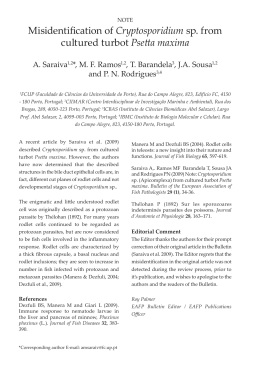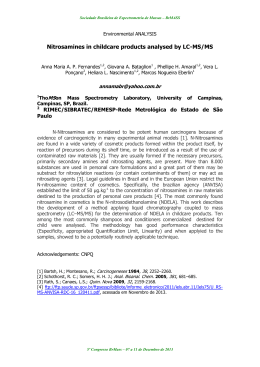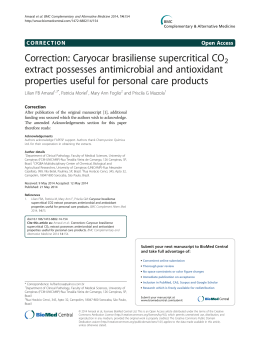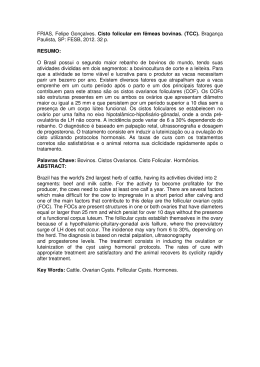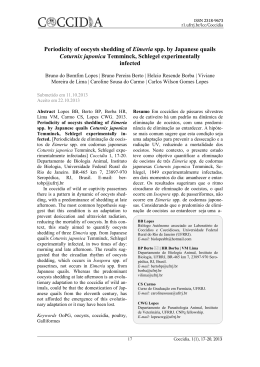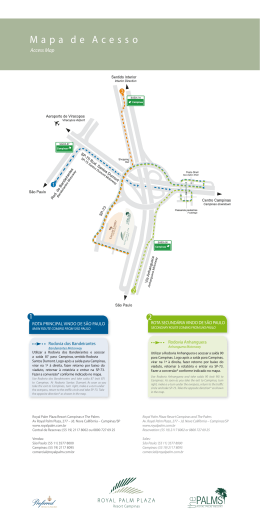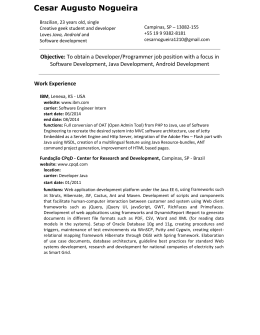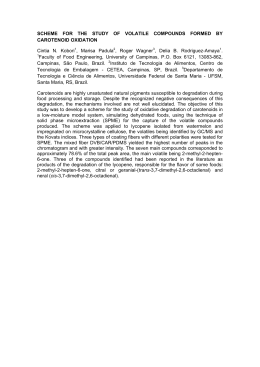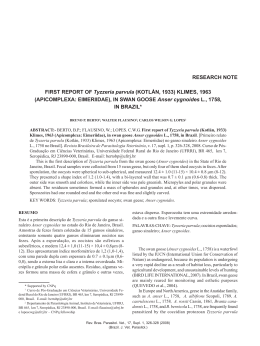Rev. Inst. Med. trop. S. Paulo 43 (2): 109-111, March-April, 2001. BRIEF COMMUNICATION OCCURRENCE OF Cryptosporidium OOCYSTS AND Giardia CYSTS IN RAW WATER FROM THE ATIBAIA RIVER, CAMPINAS, BRAZIL Regina Maura Bueno FRANCO(1), Rosângela ROCHA-EBERHARDT(1) & Romeu CANTUSIO NETO(2) SUMMARY Cryptosporidium parvum and Giardia duodenalis are waterborne parasites that have caused several outbreaks of gastrointestinal disease associated with drinking water. Due to the lack of studies about the occurrence of these protozoa in water in the Southeast of Brazil, an investigation was conducted to verify the presence of cysts and oocysts in superficial raw water of the Atibaia River. The water samples were submitted to membrane filtration (3.0 mm) and elution was processed by (1) scraping and rinsing of membrane (RM method) and (2) acetone-dissolution (ADM method). Microbiologic and chemical parameters were analyzed. Aliquots of the pellets were examined by immunofluorescence (Merifluor, Meridian Diagnostics, Cincinnati, Ohio). All water samples were positive for Cryptosporidium and Giardia, in spite of the high turbidity. Higher recovery rates occurred in samples treated by the RM method than by the ADM technique. The goal for future work is the assessment of viability of cysts and oocysts to determine the public health significance of this finding. KEYWORDS: Cryptosporidium; Giardia; Raw water; Brazil. INTRODUCTION Cryptosporidium parvum and Giardia duodenalis are waterborne parasites that have caused several outbreaks of gastrointestinal disease associated with drinking water16. However, both water-borne and person to person transmission are important, as are animal-to-animal, animalto-human, and via foodstuffs7. Cryptosporidium is a protozoan parasite of vertebrates12. The first human infection was reported in 197611. From then on it has been associated with diarrheal illness in most parts of the world7,12,16 and is considered one of the causes of traveler’s diarrhea. Cryptosporidiosis occurs in immunocompetent individuals and is a serious opportunistic infection in patients with the acquired immunodeficiency syndrome, usually resulting in chronic, prolonged and life-threatening illness7. Up to this time there is no satisfactory chemotherapy to prevent or cure cryptosporidiosis2. Giardia duodenalis is a flagellate protozoan which infects humans and other animals causing a variety of symptoms such as diarrhea, weight loss, abdominal cramps, growth stunt and is currently considered as one of the most common causes of gastroenteritis in the world13. C. parvum and G. duodenalis are transmitted by the thick-walled oocyst (2-6 mm) and cyst (8-14 mm), respectively. Person-to-person transmission is very common, especially among young children7. Nowadays, the zoonotic potential of these protozoa is already well established15. Although the importance of the waterborne route of transmission of these parasites was recognized 12 or more years ago8, waterborne outbreaks continue to occur5 and the ingestion of small numbers of oocysts or cysts is sufficient to cause infection. Microbiologic contamination of water supplies with fecal matter is very significant and oocysts or cysts are remarkably resistant to disinfectants and to routine chlorination of drinking water5. In Brazil there is limited data about the occurrence of these waterborne protozoa in raw water. Presently, there is a worldwide recommendation that systems serving populations between 10,000 and 100,000 people be required to monitor for presence of Giardia and Cryptosporidium in drinking water samples10 . It is very important to evaluate the presence of oocysts and cysts in water supplies intended for human use. Recent reports have pointed out (1) Laboratory of Protozoology, Department of Parasitology, Institute of Biology, State University of Campinas (UNICAMP), Campinas, SP, Brazil. (2) Laboratory of Microbiology, Sociedade de Abastecimento de Água e Saneamento S/A (SANASA), Campinas, SP, Brazil. Correspondence to: Dra. Regina Maura Bueno Franco, Laboratório de Protozoologia, Depto. de Parasitologia, Instituto de Biologia, Universidade Estadual de Campinas, Caixa Postal 6.109, 13083-970 Campinas, São Paulo, Brasil. FAX: +55.19.289 3124. E-mail: [email protected] FRANCO, R.M.B.; ROCHA-EBERHARDT, R. & CANTUSIO NETO, R. - Occurrence of Cryptosporidium oocysts and Giardia cysts in raw water from the Atibaia river, Campinas, Brazil. Rev. Inst. Med. trop. S. Paulo, 43(2): 109-111, 2001. that the prevalence of cryptosporidiosis and giardiasis in immunocompetent children attending day-care centers in the city of Campinas, Southeast Brazil is 6.4% and 13.5%, respectively4. The purpose of the present study was to verify the presence of Cryptosporidium oocysts and Giardia cysts in superficial raw water samples from the Atibaia River, which were impounded before treatment. MATERIAL AND METHODS The Atibaia River belongs to the Piracicaba River Basin (São Paulo State) and suffers continuous impact from industrial discharge, sewage effluents and contamination from agricultural sources. Raw water samples from the Atibaia River were collected in three subsequent weeks (groups I, II, III). The samples were collected in sterilized plastic containers at the intake to treatment plant. Microbiologic and chemical parameters (total and fecal colimetry, pH, and turbidity) were also analyzed. In the laboratory, the water samples were passed through membrane filters (45-mm-diameter, 3 mm, Millipore, Brazil) under negative pressure (4L/min). Afterwards the membranes were cut in two parts. Each membrane was submitted to sample elution by (i) alternately scraping the membrane with a smooth-edged plastic loop and rinsing it with 0.1% Tween 80 solution (RM method)14 and by (ii) the acetone-dissolution method (ADM method)6, respectively. The pellets were recuperated by centrifugation and diluted to 1.0 ml with 0.22 mm water filter system (MilliQ, Millipore, Brazil). Aliquots (10 ml) of these pellets were processed by Merifluor kits (Meridian Diagnostics, Cincinnati, Ohio) according to the manufacturer’s instructions. The Zeiss Axiolab epifluorescent microscope with a 450-490 nm excitation filter and 520 nm barrier filter was used to read the reaction. The number of oocysts/cysts was calculated by [oocyst counts in the well x vol. of pellet/ sample-well vol.] x 2. A control trial (group IV) was performed to evaluate the recovery efficiency of the methods employed by placing a known number of seed oocysts (from a suspension of oocysts obtained from fecal samples of HIV-infected-patients, Clinic Hospital, State University of Campinas) and cysts (Easy-Seed; Biotechnology Frontiers, Australia) in water filtered by 0.22 mm water-filter system (MilliQ; Millipore) submitted to the same analytical procedure. RESULTS AND DISCUSSION All examined water samples from the Atibaia River were positive for Cryptosporidium oocysts and Giardia cysts (Table 1). A higher recovery rate occurred in samples treated by the RM method than by the ADM technique, which was also corroborated in the control-trial (Table 1). The detected cysts and oocysts are in conformity with standard fluorescence detection criteria9. In many of them the Cryptosporidium suture could be observed and exhibited bright green fluorescence. The membrane filter dissolution method was originally developed for application to finished drinking water1. Presently, this method is considered particularly useful for rapid determination of the number of oocysts in raw water3. However, one disadvantage of the membrane acetone-dissolution is the hardening of the pellet containing oocysts (or 110 cysts) after the centrifugation step, which may explain the 25.5% efficiency previously reported3; the results of the control trial reveal Cryptosporidium and Giardia efficiency rates of 41.6% and 91.8% for RM procedure and 30.0% and 4.0% for ADM methods, respectively. It is noteworthy that the analyzed water samples presented high turbidity due to the intense rainfall characteristic of the season. It is possible that cyclic variations in environmental cyst and oocyst concentrations in raw water are found. The goal for future work is the development of a database on cyst and oocyst occurrence over a prolonged period of time. Simultaneously, oocyst and cyst viability will be studied to evaluate its significance as a public health risk. Table 1 Turbidity and number of Cryptosporidium oocysts and Giardia cysts detected in raw water1 from the Atibaia River by RM/ADM/immunofluorescence and in the control trial* Groups Giardia RM ADM I II III IV (control) 33.0 44.5 95.0 45.0 7.5 8.3 7.0 2.0 Cryptosporidium RM ADM 60.8 44.5 57.0 100.0 5.0 7.5 0 72.0 Turbidity (ntu) 46 32 48 — * number of seed oocysts: 480/L; number of seed cysts: 49/L; ¹ = volume of the samples: 0.5 L.; -- = not determined; RM = scraping and rinsing of membrane; ADM = acetone dissolution of membrane RESUMO Ocorrência de oocistos de Cryptosporidium e cistos de Giardia em águas do Rio Atibaia, Campinas, Brasil Cryptosporidium parvum e Giardia duodenalis são parasitos transmitidos pela água e têm causado muitos surtos de doenças gastrointestinais associados à ingestão de água. Devido à falta de estudo sobre a ocorrência destes protozoários na água, no Sudeste do Brasil, uma investigação foi conduzida para verificar a presença de cistos e oocistos na água superficial do rio Atibaia. As amostras de água foram submetidas à filtração em membrana e a eluição foi processada por: (1) lavagem e raspagem da membrana (RM) e (2) dissolução em acetona (ADM). Parâmetros microbiológicos e químicos foram analisados. Alíquotas do sedimento foram examinadas por imunofluorescência. Todas as amostras de água foram positivas, a despeito da alta turbidez. Maior taxa de recuperação ocorreu em amostras tratadas pelo RM que por ADM. A meta em futuros trabalhos é determinar a viabilidade de cistos e oocistos para se obter o significado deste achado em Saúde Pública. ACKNOWLEDGMENTS We thank Millipore of Brazil for donating the filtration membranes used in this study. FRANCO, R.M.B.; ROCHA-EBERHARDT, R. & CANTUSIO NETO, R. - Occurrence of Cryptosporidium oocysts and Giardia cysts in raw water from the Atibaia river, Campinas, Brazil. Rev. Inst. Med. trop. S. Paulo, 43(2): 109-111, 2001. REFERENCES 1. ALDOM, J.E. & CHAGLA, A.H. - Recovery of Cryptosporidium oocysts from water by a membrane filter dissolution method. Lett. appl. Microbiol., 20: 186-187, 1995. 2. COOMBS, G.H. - Biochemical peculiarities and drug targets in Cryptosporidium parvum: lessons from other coccidian parasites. Parasit. today, 15: 333-338, 1999. 3. DAWSON, D.J.; MADDOCKS, M.; ROBERTS, J. & VIDLER, J.S. - Evaluation of recovery of Cryptosporidium parvum oocysts using membrane filtration. Lett. appl. Microbiol., 17: 276-279, 1993. 4. FRANCO, R.M.B. & CORDEIRO, N. da S. - Giardiose e criptosporidiose em creches no município de Campinas, SP. Rev. Soc. bras. Med. trop., 29: 585-591, 1996. 5. FRICKER, C.R. & CRABB, J.H. - Water-borne cryptosporidiosis: detection methods and treatment options. Advanc. Parasit., 40: 241-278, 1998. 6. GRACZYK, T.K.; FAYER, R.; CRANFIELD, M.R. & OWENS, R. - Cryptosporidium parvum oocysts recovered from water by the membrane filter dissolution method retain their infectivity. J. Parasit., 83: 111-114, 1997. 7. GRIFFITHS, J.K. - Human cryptosporidiosis: epidemiology, transmission, clinical disease, treatment, and diagnosis. Advanc. Parasit., 40: 37-85, 1998. 8. HAYES, E.B.; MATTE, T.D.; O’BRYEN, T.R. et al. – Large community outbreak of cryptosporidiosis due to contamination of a filtered public water supply. New Engl. J. Med., 320: 1372-1376, 1989. 9. HOFFMAN, R.; CHAURET, C.; STANDRIDGE, J. & PETERSON, L. – Evaluation of four commercial antibodies. J. Amer. Water Works Ass., 91: 69-78, 1999. 10. LE CHEVALLIER, M.W. & NORTON, W.D. - Giardia and Cryptosporidium in raw and finished drinking water. J. Amer. Water Works Ass., 87: 54-68, 1995. 11. MEISEL, J.L.; PERERA, D.R.; MELIGRO, C. & RUBIN, C.E. - Overwhelming watery diarrhea associated with a Cryptosporidium in an immunosuppressed patient. Gastroenterology, 70: 1156-1160, 1976. 12. O’DONOGHUE, P.J. - Cryptosporidium and cryptosporidiosis in man and animals. Int. J. Parasit., 25: 139-195, 1995. 13. PICKERING, L.K. & ENGELKIRK, P.G. - Giardia lamblia. Pediat. Clin. N. Amer., 35: 565-577, 1988. 14. SHEPHERD, K.M. & WYN-JONES, A.P. - An evaluation of methods for the simultaneous detection of Cryptosporidium oocysts and Giardia cysts from water. Appl. environ. Microbiol., 62: 1317-1322, 1996. 15. SMITH, J.L. – Cryptosporidium and Giardia as agent of foodborne disease. J. Food protect., 56: 451-461, 1993. 16. STATES, S.; STADTERMAN, K.; AMON, L. et al. - Protozoa in river water: sources, occurrence, and treatment. J. Amer. Water Works Ass., 89: 74-83, 1997. Received: 25 April 2000 Accepted: 01 December 2000 111
Download

